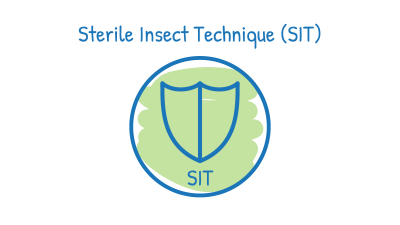Sterile Insect Technique (SIT)
An additional tool for innovative mosquito control.

Sterile Insect Technique (SIT) is an insecticide-free method used to reduce harmful mosquito populations. SIT disrupts the normal mating of mosquitoes by introducing sterile male mosquitoes into a wild population. Lab-reared sterilized males mate with the wild female population and as a result, the mosquito population can be reduced.
SIT has been used to control pest populations for over 70 years.
SIT works for three main reasons.
- Only female mosquitoes bite. The female mosquito needs proteins from blood to produce eggs. Males have one job – and they do it rather well, and that’s one reason why there are so many mosquitoes. By releasing sterile males, the risk of being bitten does not increase.
- Female mosquitoes are inseminated once in their lifetime. Meaning if they mate with a sterile male, they will never produce viable offspring.
- Mosquito species can only mate with the same species. The invasive mosquito species is the only species released and therefore, releases will not impact the ecosystem that is naturally in place.
Our mission as a District is to provide effective and environmentally sound vector control and vector-borne disease prevention programs. Although there is much more discussion and research to apply, we look forward to this technological advancement and the opportunities to our District.
This method has had great success in saving US crops and even endangered mammals. For example, the Key deer is an endangered species that only live in the Florida Keys, USA. In 2016, wildlife specialists observed Key deer dying rather gruesome deaths by way of a screwworm fly. In response, sterile male screwworm flies were released on 13 keys over a period of months. After intensive surveillance and multiple SIT releases, successful eradication of the screwworm fly was declared six months later.
SIT has also been used regularly here in California agriculture since the 1990s to protect crops from fruit flies. A 2014 study from the department of agriculture reported a 98% decrease in outbreaks by using this form of pesticide. This process is being classified by the state of California as a pesticide because it does in fact kill off pests although no chemicals are released into the environment.

